Menu
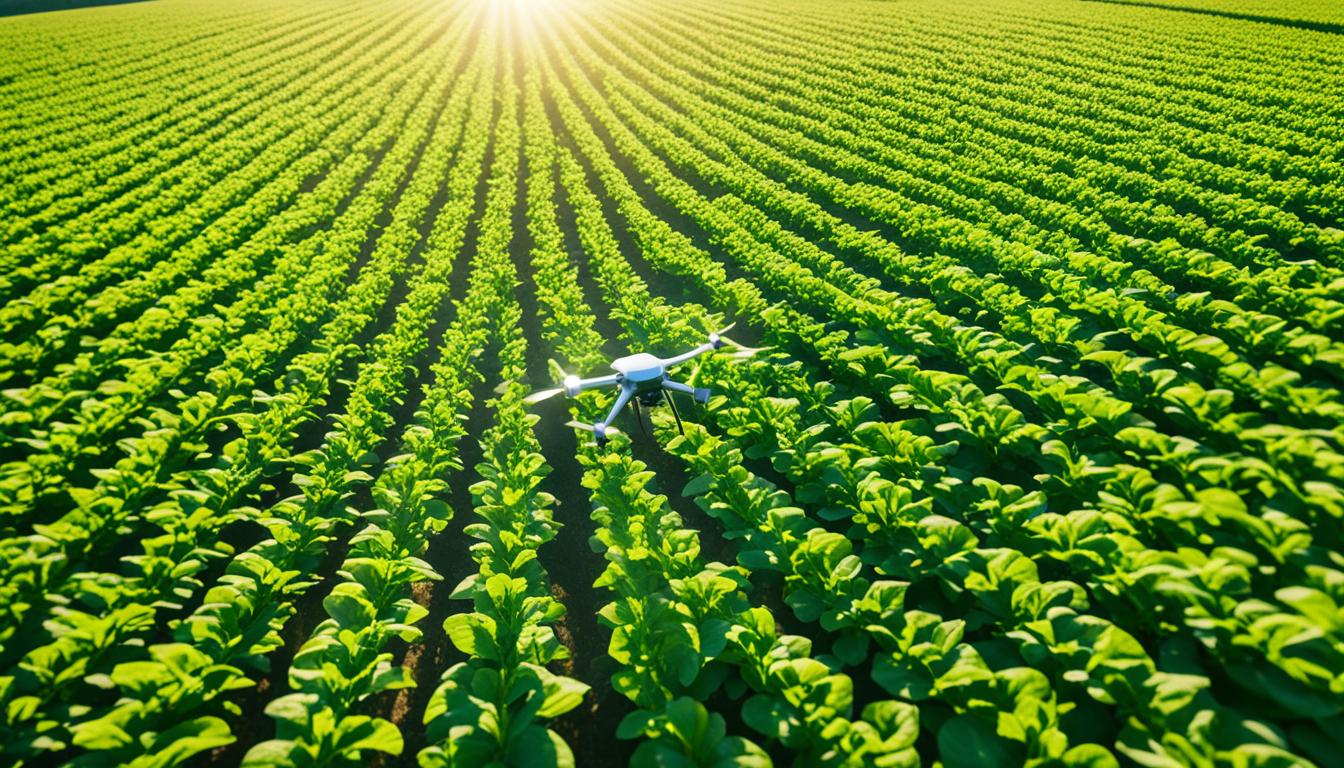
Did you know that at Rapid Innovation, more than 200 digital farmers lead in agri-tech? This is labelled the “Green Revolution 2.0,” where farming changes. The unpredictable farming of the past gives way to precise uses of AI and machine learning. By using AI farm management software, we improve how we farm. We use data from soil, weather, and plant health for better decisions. This makes our farming more efficient and sustainable.
AI is advancing fast. Companies like Rapid Innovation help grow the use of AI in farming. They partner with others to create smart farming software. This new tech boosts how well we farm and helps the planet. AI and ML are more than just new ideas. They’re changing how we do farming.
Feeding a global population of 10 billion by 2050 is a big challenge. The agricultural sector is finding innovative ways to boost crop production. The Green Revolution 2.0, powered by artificial intelligence (AI) and machine learning (ML), is bringing new methods into farming. These tools make farming more precise and efficient.
AI is leading the Green Revolution 2.0 by making farming more precise and data-driven. Farmers now can monitor and forecast environmental factors to better manage crops. AI agricultural automation makes farming both efficient and sustainable, meeting the increasing food needs.
In the past, farming was very unpredictable due to weather, pests, and diseases. Today, AI tools are incredibly accurate in these areas. They can detect apple black rot with over 90% accuracy and identify insects precisely. AI also optimises crop irrigation, saving water and finding leaks. In smart greenhouses, it adjusts conditions for the best plant growth.
AI also greatly affects livestock health. Drones with computer vision monitor animals, detecting abnormal behaviour and watching over events like birthing. AI-powered agricultural automation helps predict soil yields more accurately, uses pesticides better, and makes instant choices to boost productivity and sustainability.
| Era | Advancements |
|---|---|
| Neolithic Revolution | Shift from nomadic living to settled agricultural communities |
| Roman Era | Introduction of the plow |
| Middle Ages | Innovations like crop rotation and the three-field system |
| Industrial Revolution | Mechanization with seed drills and steam-powered tractors |
| 21st Century | Advent of AI, agricultural robots, drones, and driverless tractors |
The use of AI in agriculture is more than just a step forward; it is a complete transformation. By 2028, the market for these technologies is expected to reach USD 4.7 billion. This growth signals significant advancements in farm productivity and sustainability with advanced AI farming solutions.
AI farm management software uses advanced tools to improve farming. It relies on a platform that analyses lots of data to give useful insights. This platform can understand data from text, images, and speech.
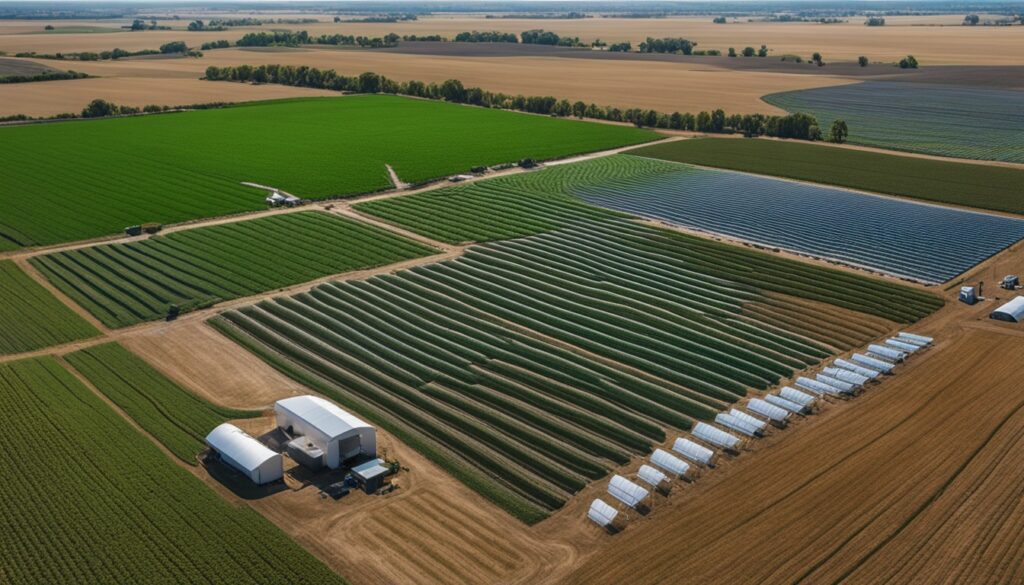
This software can detect specific insects like flies and bees with high accuracy. It helps in pest control by saving resources. It also makes farm work easier with robots. For example, drones use AI to apply pesticides accurately in fields.
Text analytics helps by looking at how people feel and monitoring livestock health. This leads to better conditions for animals and more milk production.
It’s vital for the software to understand different ways of talking, too. This makes farming devices work together smoothly. Knowing the weather well means farmers can water and fertilise crops just right. This reduces waste and makes farming more efficient.
AI is making farm machines work better, too. Tractors and water systems that drive themselves are becoming more common. They make farming cheaper and increase the amount of crops grown.
| Feature | Application | Benefit |
|---|---|---|
| Object Detection | Insect Identification | Over 90% Accuracy |
| AI-powered Drones | Pesticide Application | Resource Savings |
| Text Analytics | Health Monitoring | Improved Livestock Production |
| Language Processing | System Integration | Smoother Operations |
| Weather Data Processing | Irrigation Management | Water Conservation |
| Automated Machinery | Crop Management | Increased Yields |
AI is also used to control pests by predicting their movements from the environment. This lets farmers stop pests early, saving resources and crops.
With the world’s population growing, AI in farming is more important than ever. It’s expected to grow a lot by 2028. So, using AI and robots in farming is key to growing food well and without harming the earth.
Use of AI farm software gives the agricultural world many perks. It focuses on automated crop checks and smart agricultural tools. These tools help farmers improve crop sizes, simplify their work, and support green efforts. Exploring these wins shows how AI changes farming today.
With the world’s population set to hit 10 billion by 2050, farming must grow. AI’s predictive analytics deal with lots of data fast. This lets farmers make smart choices. They can predict market needs and prices. This optimises crop growth. AI also spots where crops need more care quickly. This helps farms be more productive.
AI farm software makes farms work better. It quickly points out where actions are needed. It uses things like driverless machines and smart watering. These technologies make farming operations faster, save resources and are more exact than people. The market for AI in farming will likely triple from 2023 to 2028. It shows how important these new tools are becoming.
Making farming sustainable is vital today. AI supports saving water and fertilisers. It spots leaks in watering systems and suggests the best for crops. AI farming saves money, water, and boosts crop sizes. This backs eco-friendly farming. It helps farms thrive and respects nature.
Precision agriculture technology is changing farming for the better. It’s making farming more efficient and effective. In the U.S., only 27 percent of farms used this tech in 2023, according to the USDA. But, big investments in research show a growing interest in these methods. Both the USDA and the NSF gave close to $200 million for this in the years from 2017 to 2021. This shows technology’s key part in today’s farming.
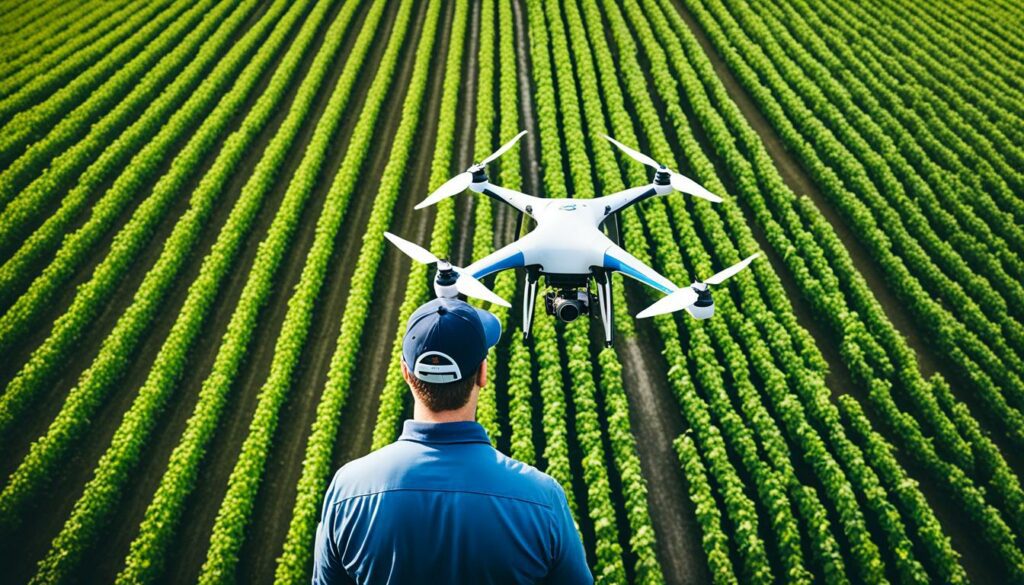
Precision agriculture uses new tech to make farming more precise and smart. It merges data from many places to offer specific advice for each farm. This improves how we manage crops and animals. It brings more profit, cuts down on waste, and helps the environment a lot. But, getting the latest tech can be expensive. This might be tough for farmers with less money.
Key technologies help make precision agriculture successful, like AI farm management software. These are:
But, there are worries about who owns and can see the data from farms. These worries slow down the use of AI in farming. People are working on rules to make it easier to use this tech, to come up with new ideas, and to handle all the data better.
The world of farming has changed a lot with robotic systems. These systems help farmers work better and care for the environment. They make farming more efficient, productive, and sustainable. This is a big step for agriculture.
Today, robotic systems in agriculture are varied and serve different needs. Let’s see some examples:
Using robotic farm management comes with big pluses for farms and the planet:
By bringing in different kinds of robots, farms can get a lot done while being good to the earth. It changes how well farms work and makes farming a strong and long-lasting way of life.
Smart farming software is changing the way we manage crops and monitor livestock. It includes tools like real-time video analysis and predictive analytics. These tools bring advanced machine learning to farming.
Using smart farming software cuts costs in areas like fuel and pesticides. For example, by planning transport routes with AI, fuel costs can be lowered by 18-22%.
Precision agriculture improves how efficiently we use resources and the crops we get. By using smart software, farms have decreased pesticide use and increased their crops. This approach has also made water use in rice fields more efficient.

Video analysis and sensors are reducing livestock diseases. For plants, like tomatoes, spotting diseases early is making a big difference. Predictive analytics are also making oyster production forecasting much more accurate.
Farm management solutions are key to these advancements. They offer a single place to manage everything on a farm. This includes real-time data, tasks, and mobile management options.
FarmERP is a great example of smart farming software in action, helping agribusinesses in over 25 countries. It focuses on making agriculture sustainable and cutting the carbon footprint. This software, combined with advanced farming techniques, is making farming more efficient and productive.
The Indian agritech sector is rapidly changing. This change is thanks to the wide use of farm management systems. These are powered by new technology. A key player in this shift is the farm data analytics platform. It uses many types of data to offer important insights.
Data is the key to making agriculture better these days. For example, by bringing together satellite images, weather info, and real-time field data, we are making farming smarter. This helps companies in agritech to improve old ways of doing things. They can use approaches that are very precise, saving money and being kinder to the planet. Big data helps do all this.
Making decisions based on data can really change how well farms work. For example, improving how we give water and nutrients might make our crops much stronger. This also helps lessen our use of harmful chemicals, which is better for the environment. Knowing about crop yields ahead of time helps farmers plan well. This makes their work more efficient, boosts their earnings, and helps cut down on wasted food.
| Benefits of Farm Data Analytics | Impacts |
|---|---|
| Optimised Resource Allocation | Cost Reductions |
| Improved Productivity | Maximised Profits |
| Reduced Environmental Footprint | Eco-Friendlier Practices |
| Accurate Crop Yield Predictions | Effective Operations Planning |
Thanks to AI farm management software, precision farming is getting even better. Using the latest tech, like smart devices, drones, and automatic machinery, farmers can get great results with less waste. This is a big step towards making farming not only more reliable but also more sustainable. By using data, farmers can handle risks like bad weather and pests better. This makes their work smarter, more profitable, and better for the environment.
In agriculture today, automated crop monitoring software is a major game-changer. It allows for precise and non-stop tracking of crop health. This software uses the latest precision agriculture technology to collect data from various environmental sensors. It then gives immediate insights into the crop’s condition, helping farmers make smart decisions.

The Tomato Guardian AI Project is a great example of this. It keeps an eye on the crops all the time. It uses sensors to check on things like how much moisture is in the soil and the temperature. It also looks for signs of diseases. This data helps farmers deal with problems early, making their farms more productive and less risky.
Precision agriculture technology does more than just watch crops. It also helps manage farms better. It makes financial plans and risk management more effective by turning farms into places that rely on data. With this technology, farmers can budget more accurately and make safer choices for their plants and animals.
As the technology keeps getting better, apps like yieldsApp and Slakes become more important. yieldsApp suggests what to do to keep pests, diseases, and nutrients under control. This protects the crops. Slakes helps understand soil health by looking at how stable the wet soil is. Both of these apps give key information on crops and soil health.
Next, let’s look at some of the top agriculture apps. They show off the power of using automated crop monitoring software and precision agriculture technology:
| App Name | Main Function |
|---|---|
| yieldsApp | Field-specific pest, disease, and nutrient management recommendations |
| Slakes App | Soil health assessment based on wet aggregate stability |
| FarmCommand | In-field data management and analysis tools |
| Libra Cart | Grain cart weighing and data management system |
| AGvisorPRO | Connection with a professional network for knowledge development |
To sum up, using automated crop monitoring software and precision agriculture technology is a big step forward in farming. It improves how we watch over and manage crops. By using these tools, we can face challenges like global competition and changing prices. They help make our farms more efficient and sustainable for the future.
The Tomato Guardian AI Project shows how powerful AI farm management software and agricultural automation solutions can be. It uses the latest AI to make farming better by analysing real-time data. This helps farmers produce more while managing their land smarter.
This project aims to greatly improve growing tomatoes using AI farm management software. It uses clever analytics and automated processes to get more crops, be kinder to the planet, and run farms better. This is super important, especially in places like Latin America, where green practices are key.
The Tomato Guardian project uses many tools to make farming more efficient:
The Tomato Guardian project has seen big improvements in farming and being eco-friendly:
| Metric | Impact |
|---|---|
| Tomato Growth | Up to 40% increase |
| Water Usage | Cut by 20% |
| Methane Emissions | Less by up to 40% |
| Crop Yields | Better by 70% worldwide |
By using AI farm management and automation, projects like Tomato Guardian change farming. They make it more modern, efficient, and better for our planet. These changes show how AI can improve traditional farming a lot.
Combining weather forecasts with AI in farming marks a big step forward. It gives farmers new tools to tackle weather challenges. Smart software uses high-tech farming to predict and suggest what to do.\

Weather data is key in farming, affecting how crops grow and when to water them. Nearly 14% of people globally face food shortages. This shows why we need better ways to farm. About 90% of farming businesses see climate change hurting their crops. Getting weather right is key to improving crops, said almost 80% of those asked.
AI tools in farming make the most of weather data. They use loads of weather info to guess things like rain, heat, and damp. Australian farmers used 20% less water thanks to a smart AI project. Benchmark Labs’ tech makes predictions that are 84% better than standard weather services.
AI also helps figure out when to water and harvest. It looks at soil wetness and weather to give advice. This is great for saving water and boosting crop quality without spending as much. Putting weather info into smart farming tools shows how tech can change farming for the better, making it more eco-friendly and efficient.
| Statistics | Data |
|---|---|
| Global Food Insecurity | 14% |
| Farmer Income Loss (last 2 years) | 16% |
| Water Savings (Murray-Darling Basin) | 20% |
| AI Impact on Agricultural Productivity by 2050 | 70% |
| Forecast Accuracy Improvement (Benchmark Labs) | Up to 84% |
Farmers today face more challenges due to global markets and volatile prices. AI farm management software helps by tracking costs and forecasting trends. This gives them an advantage in making decisions. AI is key for farmers in controlling pests and diseases, helping them keep their crops safe.
Spotting and handling crop threats early is very important for good harvests. AI farm management software let farmers use top tech for watching their crops in real time. For example, Agrio’s AI tools can spot issues and advise on treatment for diseases. This means problems can be fixed quickly.
AI is great at guessing and stopping crop diseases. Tumaini is a platform with a high success rate in catching pests and diseases early. It helps farmers in different places like Colombia and Uganda by warning them before outbreaks. This early warning system helps farmers to avoid big losses and keep their crops healthy.
Customising AI solutions for your farm is more important now than ever before. With the global population set to hit 10 billion by 2050, smart farming is the future. AI helps improve crop production by using data to make smarter choices.
To start, you need to look at your farm’s specific needs. Think about the types of crops you grow, the soil, the weather, and what tech you already have. This helps you figure out what you need from smart farming tech and precision farming tools.
Next, it’s time to pick the right AI tools for your farm. The market for AI in farming is growing fast. By 2028, it’s expected to reach USD 4.7 billion. There are tools for everything, from drones that spray pesticides precisely to systems that water crops on their own.
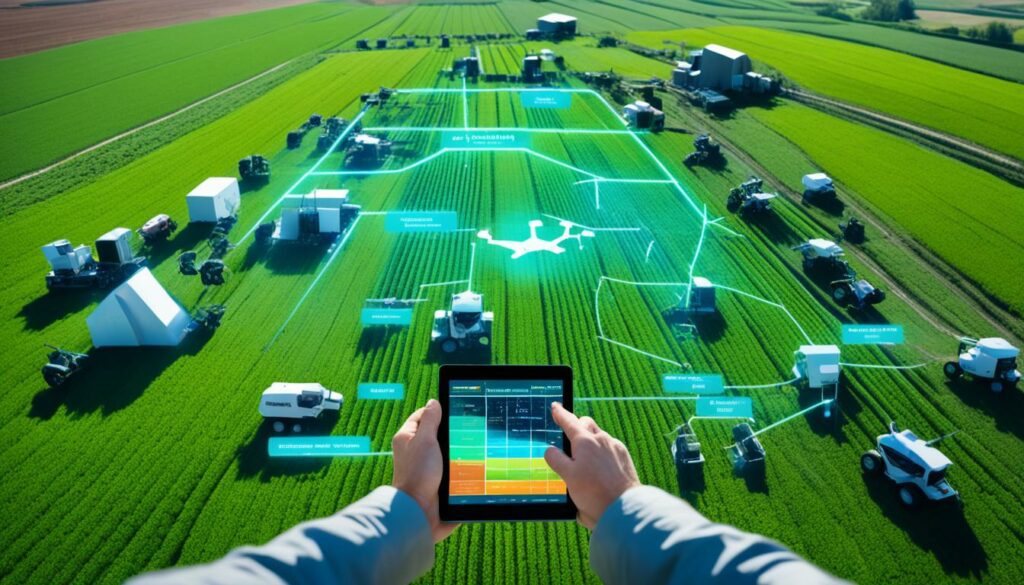
Finally, putting the AI tools into action is crucial. This can improve things like how you plant and monitor your crops. It can even help you find and treat pests more efficiently. This saves money and helps the environment.
Customising AI for your farm means understanding what you need, choosing the best tools, and using them well. AI can change farming for the better, increasing your harvest and helping the planet.
AI is quickly changing how farms are run. With the world’s population expected to hit 10 billion by 2050, there’s more pressure on farming. This push is leading to changes in two big areas: predictive analytics and autonomous farming. They use smart tools and technology to gather data and automate farm processes.
Looking into the future, predictive analytics will be key for farms. It uses AI models to guess what the market will need. This helps farmers plan when to plant and harvest. By using less weed killer and having better crops, farmers save money. These AI tools also spot problems before they happen. This reduces the chance of crops not doing well and makes farming more productive.
Thanks to AI and IoT, farming without much human help is becoming real. Machines watch soil moisture and weather all the time. This tech then waters, plants, and harvests by itself. So, farms need less work from people, which makes them more efficient and good for the planet.
The AI farming market is growing fast, and will be worth USD 4.7 billion by 2028. To keep up, farmers can use advanced data tools. These tools help them make smart choices about how they use resources. The goal is to farm in ways that last for the long term.
The use of artificial intelligence agriculture tools and smart farming software in farming is challenging. It requires solving several issues for it to work well. These include technical problems, the high cost, and concerns about data privacy and safety.
In AI agriculture, many farmers, especially smaller ones, lack the needed technical knowledge. Using smart farming software requires specific skills. However, it is not easy for everyone to get these skills. Problems with the quality and access to data are also big issues. Getting good, usable data from farms is hard, especially in poorer countries. This makes it tough to use artificial intelligence agriculture tools effectively.
The cost of AI technology in farming is very high, which puts it out of reach for some farmers. This covers the price of the technology itself, like hardware and software. Even though using AI can help farmers save money and produce better crops over time, its initial cost is a major challenge. Making these technologies more accessible is crucial. This way, more farmers can use them and benefit from them.
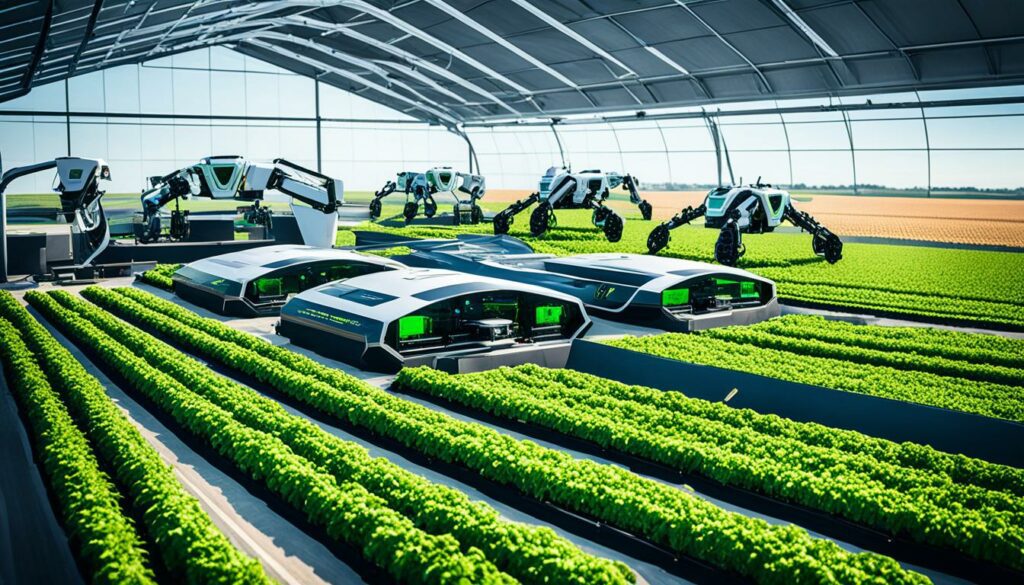
Farmers worry about the safety and privacy of their data when they use artificial intelligence agriculture tools and smart farming software. They fear that data breaches could endanger their farming operations. There are also concerns about how AI might affect jobs in farming and whether it might be unfair. Addressing these issues will help more farmers trust and use AI in their work.
Overcoming these challenges will take cooperation between governments, private companies, and farmers. Working together will make the use of AI in agriculture better. It will also ensure that its benefits reach everyone fairly.
Artificial intelligence (AI) tools are changing the way we farm. They are essential for sustainable farming. This is crucial as the world’s population is expected to hit 10 billion by 2050. The market for AI in agriculture is growing fast, from USD 1.7 billion in 2023 to USD 4.7 billion by 2028. This growth shows how much we rely on AI to produce more food while protecting the environment.
AI predicts what farming areas need better management, such as irrigation or fertilisers. It helps save resources and cuts down on harmful substances used. This leads to better crop quality and more money for farmers. Also, with precision agriculture, farmers can grow more food using fewer resources.
AI also helps by spotting problems early, like crop diseases, thanks to over 90% accurate systems. These technologies save water and energy, up to 50% and 15%, which is great for the planet. Plus, using solar panels and wind turbines for energy makes farming even more green.
In short, using AI in agriculture is not just about new technologies. It’s a big step towards farming that doesn’t harm the Earth. AI can reduce greenhouse gases by 35% and make soil 70% more fertile. With precision agriculture, we could also produce 20% more food. This is good news for the planet and our future food needs.
AI farm management software uses artificial intelligence to enhance farming. It focuses on improving crop health, predicting yields, and managing resources. Basically, it turns farming into a science backed by data, which boosts precision and efficiency.
AI and machine learning play a key role in the Green Revolution 2.0. They make agriculture more accurate by using data to replace unpredictable traditional methods. This helps farmers deal with the environment better and make smarter choices.
AI tackles problems like bad weather, pests, and waste in farming. It does this by using data to make more accurate predictions and developing smart management plans.
These platforms use big data to pull out important insights. They look at things like soil health, upcoming weather, and plant conditions. Then, they help farmers make better decisions and streamline their operations.
The main advantages are more crops, better farm operations, and a greener approach. AI helps by taking quick actions throughout the farming process. This leads to bigger harvests, more efficiency, and practices that are kinder to the planet.
Precision agriculture uses technology to make growing crops more accurate and efficient. It includes tools and systems that carefully watch over crops. The data they gather guides farmers in making decisions based on solid information.
Farming robots can do a lot, like spotting objects, keeping an eye on things, and helping with planting and harvesting. They make farming more precise and cut down on the need for manual work, which in turn improves farm management.
Smart farming brings together tools for analysing videos, texts, and weather, as well as handling data from sensors. All this supports the use of machine learning on farms.
By digging into big data, these platforms find useful advice for farmers. They look at lots of different information to help make choices that boost the farm’s performance and profits.
This software uses sensors and AI to keep a constant eye on crop health. It gives real-time updates and advice, allowing farmers to make quick changes to keep their crops in the best condition.
The Tomato Guardian AI Project watches over tomato crops using AI and environmental sensors. By adjusting farming methods based on fresh weather data, it helps increase crop yield and supports sustainable farming.
Knowing the weather is vital for good farming. AI uses the latest forecasts to suggest the best times for planting, watering, and harvesting. This helps farmers dodge bad weather and make the most of the good days.
AI uses real-time checks and predictions to spot pests and diseases early. It offers new ways to handle these threats, making crops healthier and lessening damage.
To tailor AI to your farm, figure out its unique needs and pick the right tech. Make sure you know what you want from AI tools to get the most out of them.
The future will likely see more predictive analytics and an increase in autonomous farming. This means farms will run more efficiently and precisely with less human input.
There are some big hurdles to cross, like the complexity of AI, its costs, and privacy concerns with lots of data. But, getting past these issues is key for AI to work well in farming.
AI helps make farming more sustainable by using resources better and cutting waste. This moves farming towards being more environment-friendly and able to last for a long time.